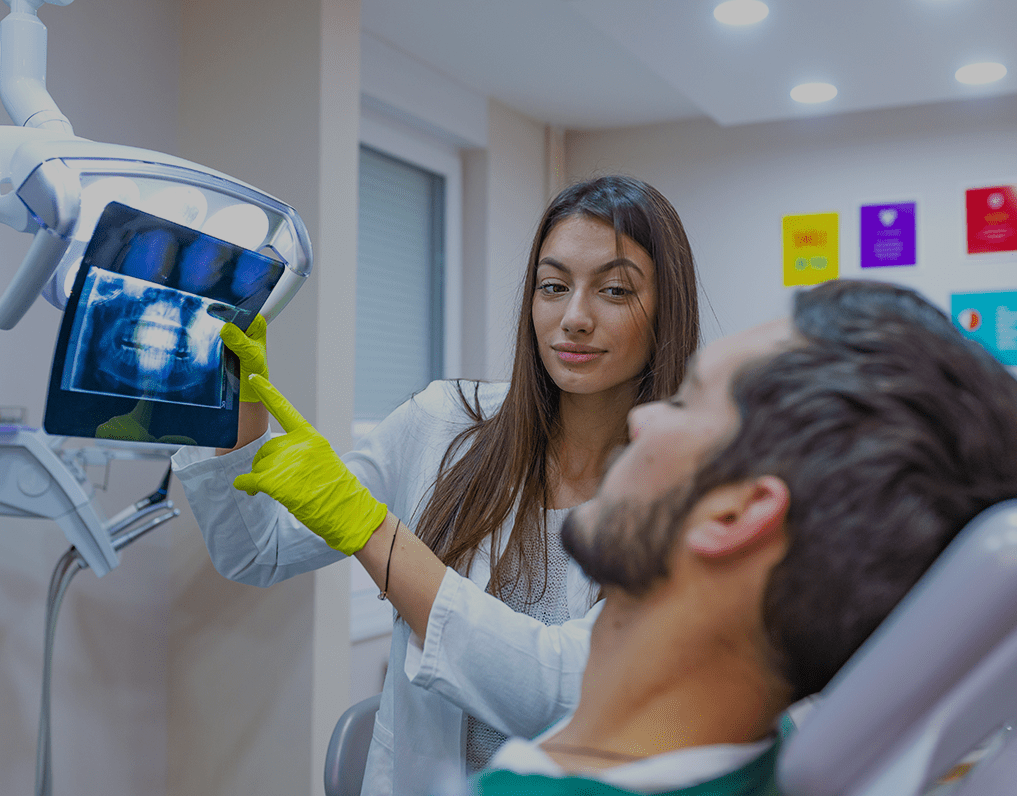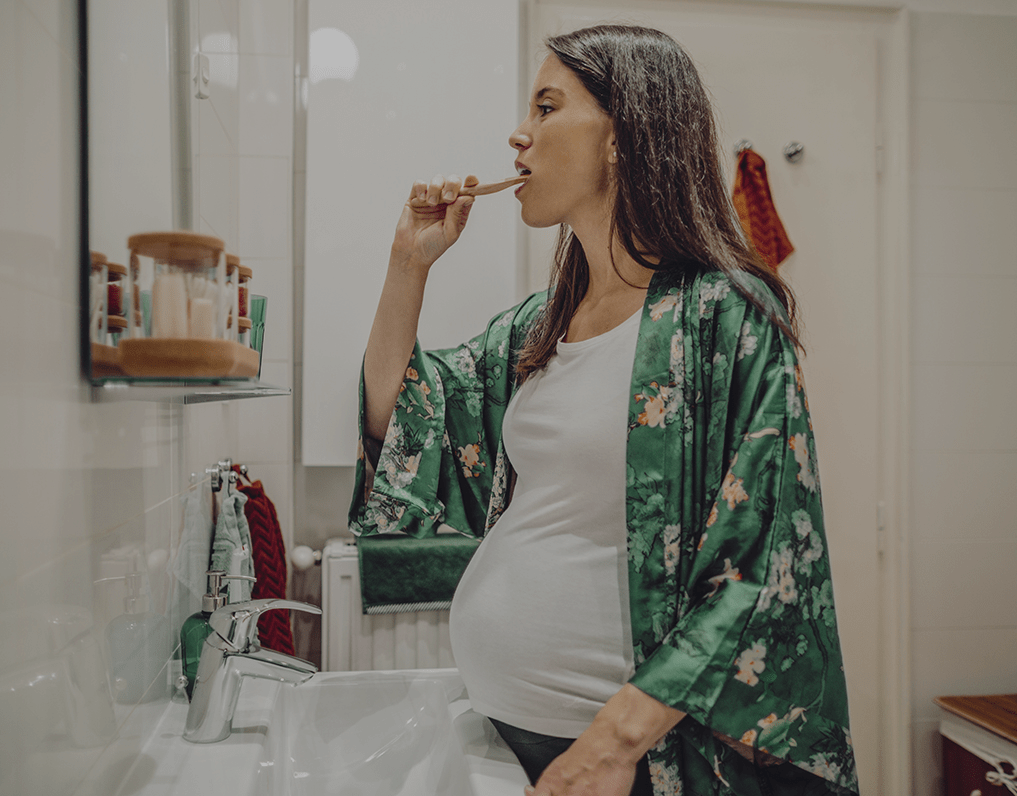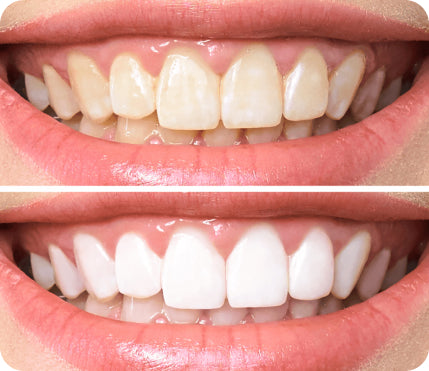
All products are certified by dental expert Dr. Greg Grillo
Having a bright, white smile is something that many of us desire. In fact, the global tooth whitening industry is projected to reach $8.21 billion by 2026, indicating a huge demand.
But sometimes, our teeth can become stained and discolored because of aging, diet, or other lifestyle habits. The good news is that it is possible to whiten yellow teeth and restore your pearly whites back to their former glory.
In this comprehensive guide, we will discuss various methods you can use to whiten your teeth safely and effectively, along with some key information to keep in mind along the way. So if you're ready to learn more about how you can achieve a brighter, whiter smile, read on below.
What Causes Yellow Teeth?
Though not as much of a priority compared to other dental issues, yellow teeth can have an impact on your self-esteem and willingness to show off your smile.
Fortunately, it is possible to modify the color of your teeth through dietary changes and optimizing your oral hygiene habits. You may even find that visiting a dentist for whitening treatment can give you the results you desire.
Understanding the different causes of yellow teeth can help you take steps toward improving your teeth and the overall appearance of your smile.
Diet
Diet can be a major factor in the discoloration of your teeth. Eating and drinking certain foods and beverages can cause staining or yellowing of the enamel, which is the outermost layer of your teeth.
One of the most common causes of yellow teeth is eating or drinking anything that contains chromogens, which are molecules that have been found to bind to tooth enamel and cause discoloration.
This includes things like red wine, dark-colored juices, berries, and other brightly colored fruits, as well as sauces such as tomato sauce. All these foods contain strong pigments that will stain your teeth.
Another cause of yellowing may be eating or drinking things that are high in sugar and acid, such as candy and soda. Sugar and acids can erode away the enamel on your teeth, which makes it easier for stains to set in. Certain foods like potatoes, apples and other crunchy fruits can wear away at the enamel as well.
Smoking Or Vaping
Smoking and vaping can cause yellow teeth because of the presence of nicotine in cigarettes and e-cigarettes.
Nicotine is a naturally occurring alkaloid found in tobacco plants, which stains the enamel on your teeth over time. Tar, an ingredient in cigarettes, is another byproduct of smoking that accumulates on tooth surfaces, creating an unattractive yellowing effect.
In addition to staining your teeth, smoking also affects your oral hygiene routine negatively as it reduces saliva production, leading to a dry mouth and making it more difficult for you to remove food particles from between your teeth with regular brushing.
Vaping has similar effects as nicotine is still present in e-cigarettes. The added flavoring compounds in e-liquids also cause a yellowing effect on the surface of teeth and tongue, as well as other oral health issues.
Infrequent Tooth Brushing
When you don't brush your teeth regularly, plaque builds up on the surfaces of your teeth and hardens into tartar.
Plaque is made up of bacteria that feed on sugars in the mouth, producing acids that break down the enamel on the surface of your teeth. This causes discoloration as well as other problems like cavities and gum disease.
In addition to these bacterial deposits, yellowing can also occur when particles from food and drinks that contain pigments become trapped within plaque deposits due to infrequent brushing. These particles can cause discoloration and further contribute to yellowing teeth over time.
Poor Oral Hygiene
Yellow teeth are a sign of poor dental hygiene. When plaque builds up on teeth, it traps food particles and bacteria. These bacteria produce acids that wear away the enamel of the tooth, leading to discoloration.
If left unchecked, these bacterial buildups can cause even further staining due to their dark pigments. Poor oral hygiene also encourages the overgrowth of yeast in the mouth, which can lead to yellowing or discoloration around the gums and between teeth.
Drinking A Lot Of Tea And Coffee
Coffee and tea lovers, proceed with caution. Drinking a lot of tea and coffee can cause yellow teeth due to the tannins contained in these beverages.
Tannins are polyphenols, which are antioxidants that can attach to proteins and can accumulate on your teeth, creating a yellowish appearance. Additionally, the acidity in tea and coffee can wear away enamel over time, resulting in tooth discoloration. The darker the beverage, the more staining potential it has, since darker colors contain higher levels of tannins and other compounds that may stain your teeth.
Age-Related Factors
As you age, the enamel on your teeth will start to break down and erode. This exposes the dentin underneath, which is naturally yellow. The thinning of the enamel and the presence of dentin can cause your teeth to look darker.
Dentin is a layer of the tooth situated beneath the enamel and before reaching the pulp cavity, which contains nerves and blood vessels. It should be noted that if this layer is exposed due to decay, it may cause several issues.
Certain medications, such as antibiotics, can also lead to discoloration in older adults. Even medical treatments like chemotherapy and radiation therapy could lead to yellowing teeth with age.
Intrinsic Factors
Teeth stains can be split into two categories, intrinsic and extrinsic. Intrinsic stains are embedded within the tooth structure and can only be lightened with a bleaching agent. Extrinsic stains, on the other hand, form on the outer surface due to pigment-containing substances accumulating there over time.
Intrinsic discoloration is more permanent in nature compared to extrinsic staining and typically results from oral injury and certain medications (like tetracycline).
Genetics can influence both the natural shade of a person's teeth and intrinsic staining, which may occur as part of tooth development or with aging. Depending on an individual's characteristics and the degree of stain, teeth whitening products could have varied outcomes.
Can Yellow Teeth Be Whitened?
Right now, thousands of people are asking themselves, "Is it possible to whiten yellow teeth?" The answer is yes.
A common method of achieving this is through a process called tooth bleaching, and which involves applying a special solution to the teeth that helps to remove stains and discoloration. At-home teeth whitening kits and teeth whitening toothpaste are also widely available for easy and convenient teeth whitening.
It should be noted that teeth whitening isn't a permanent fix, as periodic touch-ups may be needed to maintain the desired level of whiteness. Additionally, it's best to consult with a dentist before undergoing any kind of teeth whitening procedure, as some methods can cause damage if not done correctly or used too often.
Best Ways To Whiten Yellow Teeth
You can lose confidence if you have yellow teeth, not to mention the fact that it can also be a sign of improper oral hygiene, which nobody wants.
Let's take a look at some of the most effective ways to whiten really yellow teeth quickly and effectively so you can smile like a winner again in no time.
Whitening Toothpaste
For those who are looking for an easy and affordable way to achieve whiter teeth, whitening toothpaste may be just what you need.
Whitening toothpaste works by removing surface stains on the enamel of your teeth that cause discoloration. It contains mild abrasives that help scrub away plaque and surface stains while also providing a protective barrier against future staining.
Some brands also contain additional ingredients, such as hydrogen peroxide (or baking soda), which can further enhance the whitening effect. In terms of results, whitening toothpaste generally takes several weeks to show any noticeable difference in the color of your teeth.
In-Office Bleaching
An appointment with the dentist for in-office bleaching is the most effective way to whiten yellow teeth.
Unlike other over-the-counter teeth whitening options that can take weeks or months to see any noticeable changes in the color of your teeth, this procedure typically only takes one hour.
The difference between teeth whitening and bleaching is that the former involves removing surface stains to bring teeth back to their original hue, while the latter uses chemical agents to lighten the shade of tooth enamel, potentially making it lighter than its natural color.
One of the main advantages of this method over other whitening procedures is that it targets specific areas with precision, resulting in more even coloration across all surfaces. Additionally, professional-grade products are used, which will create brighter results that last longer than those from at-home kits.
In-Office Whitening
When it comes to whitening yellow teeth, in-office teeth whitening is often regarded as a more convenient option than bleaching. A dentist's office typically utilizes a stronger concentration of hydrogen peroxide for teeth whitening than those available to use at home.
This helps to remove surface stains caused by coffee, tea, tobacco products, red wine, or other dark-colored beverages that can cause discoloration. Treatment with this method is known to be effective fast, with results that often last longer than other means.
At-Home Whitening
At-home teeth whitening is one of the most popular ways to whiten yellow teeth quickly and easily without visiting a dentist. Not only is it more convenient than professional treatments, but it’s also less expensive, making it the most cost-effective option for those who are looking for an easy way to get whiter teeth.
When choosing an at-home whitening product, choose one that is specifically formulated for your particular tooth type and color. If you have sensitive teeth, opt for a product with a lower concentration of bleaching agents.
Additionally, those with darker teeth may want to opt for an option like custom trays with stronger bleaching agents in order to achieve the best results possible.
Ensure that you follow the instructions on the package carefully to get the most out of your at-home whitening treatment.
Proper Brushing
Brushing your teeth properly is often overlooked, but it's one of the best ways to keep your teeth looking white and bright. Brushing rids your teeth of plaque, which darkens their shade.
Also, remember that brushing does more than just clean the outside surfaces - it eliminates food particles lodged between or on the backside of your teeth, so bacteria and plaque don't have a chance to form.
When you brush, angle your toothbrush at 45 degrees towards your gums and use short strokes that go back and forth over each surface of each individual tooth. Brush your tongue and all areas with stains so that bacteria aren't left behind.
Veneers
Individuals who have already attempted to mask yellow teeth and been unsuccessful may find the most benefit from veneers. In dentistry, veneers are thin shells that can be made from either porcelain or composite material and are used to cover the front surface of teeth.
This provides an opportunity to hide discoloration, unevenness, and other imperfections, as well as create a brighter smile. People who get this treatment typically report feeling more self-assured about their smiles and no longer experiencing anxiety related to their appearance.
Here are some more noteworthy points you should know about whitening yellow teeth.
Why Are My Teeth Yellow When I Brush Them Every Day?
Despite regular brushing, certain foods and drinks can cause teeth discoloration. For example, coffee, tea, and wine are known to lead to the yellowing of the enamel.
Moreover, daily brushing may not be enough for smokers who experience this issue due to their habits. Some people also have a natural yellow teeth because of genetics, and age also affects tooth color as the enamel becomes thinner with time, making it more vulnerable to staining.
If none of these causes apply to you and you still have yellowing teeth, it may be a wise idea to speak with your dentist. They can evaluate the cause and suggest an appropriate remedy, such as professional whitening or bonding.
Does Teeth Whitening Work On Yellow Teeth?
While there are many ways to make your smile brighter and whiter, not all of them work as advertised on yellow teeth. However, there are plenty of excellent options. Professional teeth whitening, for instance, can restore your teeth to their natural color, and at-home whitening kits can be a convenient and cost-effective alternative.
There are some solutions that work better than others, so before trying out any new whitening procedures, consult your dentist and learn more about the cause of the discoloration of your teeth.
How Do Dentists Fix Yellow Teeth?
Most stains can easily be lifted from the teeth with professional whitening treatments. Dentists may employ several methods to treat yellow teeth.
One common procedure involves dissolving and removing stains from teeth using hydrogen peroxide or carbamide peroxide. This solution may be applied directly to the discolored areas through trays or special strips, and an ultraviolet light might be used to expedite the bleaching process.
In cases of more serious discoloration, your dentist may suggest covering your teeth with veneers. Crowns may be necessary if there has been significant enamel damage.
How Long Will It Take Yellow Teeth To Turn White?
The length of time it takes to whiten yellow teeth depends on the extent of discoloration and your oral health. A mild or moderate amount of discoloration due to food and drink can be improved with whitening toothpaste, usually within a few weeks or months.
If you have more serious staining from genetics or medication use, professional treatments are likely necessary to restore your teeth to their original shade. Most treatments only take a few hours at a time, but you will likely need to schedule several appointments to complete the process.
Prior to starting a whitening regimen, any existing dental issues, such as cavities or gum disease, must be addressed.
Can You Fix Yellow Teeth Naturally?
There are teeth whitening products available at home that can be used to fix yellow teeth. You can fix yellow teeth naturally by improving your oral hygiene and making sure you brush and floss thoroughly.
A simple way to care for your teeth at home is by mixing baking soda and hydrogen peroxide together to form a paste. This mixture is said to help diminish plaque, bacteria, and discoloration. After using the paste, simply rinse your mouth with water.
Other natural remedies, such as brushing with activated charcoal or swishing with coconut oil, may also aid in removing the buildup of plaque and staining from the teeth.
You should be aware that these home treatments may not be sufficient to brighten your smile on their own. You should still schedule regular dental cleanings with your dentist to remove surface stains and plaque buildup from your teeth.
Are Yellow Teeth Healthy?
Although discoloration caused by plaque and staining is not healthy, it's possible for yellow teeth to be clean and healthy.
If you see your teeth are discolored in dark shades like brown, black, or green, it could be an indication of ongoing dental disease, and you may need to consider getting a professional dental cleaning. In contrast, some healthy teeth may appear off-white or slightly yellow, as many people’s teeth tend to simply darken with age.
Generally speaking, yellow teeth could be a sign of poor dental hygiene or an underlying dental problem. For this reason, regular dental checkups are essential so that the dentist can evaluate your mouth and advise you on the correct dental treatment.
Why Are My Teeth Yellow But Have White Spots?
The white marks that appear on yellow teeth are usually caused by a lack of minerals like calcium and phosphorus in the enamel layer. Deficits in these nutrients result in demineralization.
Demineralization of the teeth is the result of acid damage from two sources: acidic food and beverages, and bacteria in the mouth. This process can cause the tooth to look less smooth, leading to plaque buildup, tartar, discoloration, and sensitivity when brushing.
One way to prevent demineralization and even reverse it is through the use of fluoride. You could also chew sugarless gum, as the saliva created while doing so offers excellent protection for tooth enamel.
Do Yellow Teeth Mean Decay?
Discoloration of the teeth, particularly near the gum line, may be an indication of potential decay and other oral health issues. This is due to bacteria in the mouth producing acids that break down tooth enamel and reveal dentin beneath it. Over time, this can cause further sensitivity and a yellowing or browning appearance.
It is recommended that you consult a dentist who can prescribe treatments such as fillings and crowns to protect your teeth and restore them.
Wrapping Up
It is understandable that having yellow teeth can cause embarrassment and a lack of confidence. Fortunately, there are many ways of whitening yellow teeth at home and at your dentist’s office.
You may choose to use natural ingredients or over-the-counter products, but it is recommended that you seek dental advice before beginning any tooth whitening regimen, as some methods may cause sensitivity or other oral problems.
With the right combination of lifestyle habits and proper dental care, you can have a bright, white smile that will bring out your best features and help boost your self-confidence!











